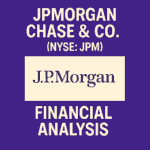Wells Fargo & Company (NYSE: WFC)
Q2 2025 Financial Analysis | July 15, 2025
Executive Summary
Wells Fargo delivered strong second quarter 2025 results, with net income of $5.5 billion, or $1.60 per diluted share, representing significant improvement from both the prior quarter and year-ago period. The quarter marked a historic milestone with the lifting of the Federal Reserve’s asset cap, enabling the bank to pursue growth opportunities previously constrained since 2018. Revenue increased 1% year-over-year to $20.8 billion, driven by fee income growth and strong credit performance. The bank continued aggressive capital returns, repurchasing $3.0 billion in common stock and announcing a 12.5% dividend increase.
Q2 2025 Highlights
Financial Performance
Wells Fargo’s second quarter 2025 results demonstrated strong financial performance across key metrics. Net income increased 12% year-over-year to $5.5 billion, driven by revenue growth, disciplined expense management, and continued strong credit quality. Diluted earnings per share of $1.60 represented a significant 20% increase from the prior year, benefiting from both earnings growth and share count reduction through repurchases.
Total revenue grew 1% to $20.8 billion, with net interest income of $11.7 billion declining 2% due to lower interest rates on floating rate assets and deposit mix changes, partially offset by favorable deposit pricing and lower market funding costs. Noninterest income increased 4% to $9.1 billion, including a $253 million gain from the merchant services joint venture acquisition and higher fee-based revenues.
The provision for credit losses increased to $1.0 billion from $932 million in the prior quarter, reflecting modest reserve builds for credit card portfolios on higher balances. Net charge-offs remained low at 0.44% of average loans, demonstrating the strength of the bank’s credit quality and disciplined underwriting standards.
Return on Equity improved to 12.8% from 11.5% in the prior year, while Return on Tangible Common Equity reached 15.2%, up 150 basis points year-over-year. These metrics reflect the bank’s strong capital efficiency and earnings generation capability in the current environment.
The efficiency ratio of 64% matched the prior year level despite increased investments in growth initiatives, demonstrating effective expense management while the bank continues to invest in technology, digital capabilities, and business expansion following the asset cap removal.
Operating Segment Performance
| Segment | Revenue ($M) | YoY Change | Net Income ($M) | Key Drivers |
|---|---|---|---|---|
| Consumer Banking and Lending | $9,228 | +2% | $1,863 | Higher credit card balances, lower deposit costs |
| Commercial Banking | $2,933 | -6% | $1,086 | Lower rates offset by higher treasury management fees |
| Corporate and Investment Banking | $4,673 | -3% | $1,737 | Higher investment banking fees, stable markets revenue |
| Wealth and Investment Management | $3,898 | +1% | $480 | Higher asset-based fees from market appreciation |
Consumer Banking and Lending delivered solid performance with revenue increasing 2% to $9.2 billion. Consumer, Small and Business Banking revenue grew 3% driven by favorable deposit pricing and higher balances. Credit Card revenue increased 9% on higher loan balances, while Auto and Personal Lending faced headwinds from lower balances and margin compression. Net income increased 5% to $1.9 billion.
Commercial Banking revenue declined 6% to $2.9 billion, primarily due to the impact of lower interest rates on net interest income, though this was partially offset by 13% growth in noninterest income driven by higher treasury management fees and tax credit investments. The segment benefited from a provision release, contributing to 37% quarterly net income growth to $1.1 billion.
Corporate and Investment Banking revenue decreased 3% to $4.7 billion. Banking revenue declined 7% due to lower rates, while Investment Banking fees increased 8% with higher advisory revenues. Markets revenue was relatively stable with strength in FICC offsetting lower Equities performance. Net income decreased 3% to $1.7 billion but remained strong.
Wealth and Investment Management revenue was stable at $3.9 billion with higher asset-based fees from market appreciation offsetting lower net interest income. Total client assets reached $2.3 trillion, up 7% year-over-year, driving fee income growth. Net income declined slightly to $480 million but showed improvement from the prior quarter.
The lifting of the asset cap positions all segments for potential growth acceleration, particularly in Commercial Banking and Corporate Banking where the bank can now compete more aggressively for large commercial relationships and expand lending capacity.
Historic Asset Cap Removal
The Federal Reserve’s lifting of the $2 trillion asset cap in Q2 2025 represents the most significant milestone in Wells Fargo’s transformation journey. The cap, imposed in February 2018 following operational risk management deficiencies, had constrained the bank’s growth for over seven years.
Transformation Achievements
- Regulatory Progress: Terminated 13 consent orders since 2019, including 7 in 2025 alone, demonstrating sustained compliance improvements
- Risk Management: Comprehensive overhaul of operational risk management, compliance infrastructure, and governance frameworks
- Cultural Transformation: Enhanced focus on customer satisfaction, ethical conduct, and operational excellence
- Technology Investments: Significant upgrades to systems, controls, and monitoring capabilities
CEO Charlie Scharf emphasized: “We are a far stronger company today because of the work we’ve done. This is a huge accomplishment, and I appreciate the focus and dedication that was required of everyone at Wells Fargo.”
Growth Opportunities Unlocked
The asset cap removal immediately enables Wells Fargo to:
- Compete for large commercial relationships previously constrained by balance sheet limits
- Expand mortgage origination and commercial lending capacity
- Pursue strategic acquisitions to enhance capabilities and market position
- Grow deposit gathering and wealth management assets under management
- Invest more aggressively in technology and digital transformation initiatives
While the immediate impact may be modest given current market conditions, the removal provides Wells Fargo with strategic flexibility that had been constrained for over seven years, positioning the bank to capitalize on future growth opportunities as economic conditions improve.
Credit Quality & Risk Management
Wells Fargo continued to demonstrate strong credit performance across all loan portfolios, reflecting disciplined underwriting standards and the healthy financial position of both commercial and consumer customers:
Key Credit Metrics
- Net Charge-offs: 0.44% of average loans (annualized), down from 0.57% in the prior year
- Nonaccrual Loans: $7.8 billion, or 0.84% of total loans, improved from 0.92% in Q2 2024
- Allowance for Credit Losses: $14.6 billion, or 1.58% of total loans, reflecting adequate coverage
- Commercial Charge-offs: 0.18% annualized, with continued strength across most sectors
- Consumer Charge-offs: 0.81% annualized, down from 0.86% in Q1 2025
The $1.0 billion provision for credit losses reflected modest reserve builds, primarily for credit card portfolios on higher loan balances, while commercial real estate reserves were reduced on lower balances, particularly in the office portfolio. This provision level represents normalized credit costs as the bank maintains appropriate reserves for potential economic uncertainties.
Nonperforming assets decreased 3% from the prior quarter, driven by improvements in commercial real estate, particularly office properties. The continued decline in nonaccrual loans demonstrates effective workout capabilities and portfolio management.
Management noted that “strong credit performance continues to point to the strength of our commercial and consumer customers’ financial position,” indicating underlying portfolio quality remains robust despite broader economic uncertainties.
Capital Management & Shareholder Returns
Wells Fargo maintained a strong capital position while executing aggressive capital return strategies, demonstrating confidence in its financial strength and future earnings capacity:
Capital Position
- CET1 Ratio: 11.1%, up from 11.0% in the prior year, well above regulatory minimums
- Total Equity: $183.0 billion, providing substantial loss-absorbing capacity
- Tangible Common Equity: $139.1 billion, supporting strong ROTCE metrics
- Stress Capital Buffer: Reduced to 3.7% from 3.8%, with further decrease to 2.5% expected
The bank successfully completed the 2025 Comprehensive Capital Analysis and Review (CCAR) stress tests, with the Federal Reserve reducing the stress capital buffer, indicating improved risk profile and capital efficiency.
Shareholder Returns
Wells Fargo demonstrated strong commitment to returning excess capital to shareholders:
- Repurchased $3.0 billion of common stock in Q2 2025 (43.9 million shares)
- Total share repurchases of over $6 billion in the first half of 2025
- Quarterly dividend expected to increase 12.5% to $0.45 per share in Q3 2025
- Fully diluted share count decreased by approximately 2.5% year-over-year
CEO Scharf noted: “During the first half of this year, we repurchased over $6 billion of common stock and as previously announced, we expect to increase our third quarter common stock dividend by 12.5%.”
The aggressive capital return program reflects management’s confidence in the bank’s earnings trajectory and ability to generate excess capital while maintaining regulatory requirements and supporting business growth following the asset cap removal.
Outlook & Strategic Priorities
With the asset cap removed and regulatory transformation largely complete, Wells Fargo is positioned to pursue growth opportunities while maintaining its focus on operational excellence and risk management:
Near-term Priorities
- Organic Growth: Pursuing customer acquisition and wallet share expansion across all business lines
- Digital Investment: Continued technology investments to enhance customer experience and operational efficiency
- Market Share Gains: Competing more aggressively for commercial relationships and wealth management clients
- Fee Income Growth: Expanding advisory, wealth management, and treasury services
Economic Environment Considerations
Management acknowledged ongoing economic uncertainties while noting activity levels have remained consistent. Key factors being monitored include:
- Interest rate environment and potential Fed policy changes
- Commercial real estate market dynamics, particularly office properties
- Consumer spending patterns and credit demand
- Geopolitical risks and their impact on corporate investment
CEO Scharf concluded: “We now have the opportunity to grow in ways we could not while the asset cap was in place and are able to move forward more aggressively to serve consumers, businesses, and communities to support U.S. economic growth.”
The bank’s strong capital position, improved operational infrastructure, and proven ability to generate consistent returns provide a solid foundation for pursuing growth opportunities as they emerge in the evolving economic landscape.
Risks & Opportunities
Opportunities
Risks
Conclusion
Strengths
- Historic asset cap removal unlocking growth potential
- Strong financial performance with 12% net income growth
- Excellent credit quality with low charge-off rates
- Aggressive capital returns demonstrating shareholder commitment
- Diversified revenue streams across business segments
Areas to Monitor
- Execution of growth strategy following asset cap removal
- Net interest margin pressure from rate environment
- Commercial real estate portfolio performance
- Technology investment ROI and operational efficiency
- Maintaining regulatory compliance and risk management standards
Summary
Wells Fargo delivered exceptional second quarter 2025 results, highlighted by the historic removal of the Federal Reserve’s asset cap after seven years of regulatory constraints. Net income of $5.5 billion and diluted EPS of $1.60 represented strong year-over-year growth, while the bank maintained excellent credit quality and continued aggressive capital returns to shareholders.
The asset cap removal represents a transformational milestone, enabling Wells Fargo to pursue growth opportunities across all business segments that were previously constrained. Combined with strong capital ratios, diversified revenue streams, and proven operational capabilities, the bank is well-positioned to capitalize on market opportunities while maintaining prudent risk management.
Revenue growth of 1% to $20.8 billion demonstrated resilience in a challenging rate environment, with noninterest income growth of 4% offsetting pressure on net interest income. The bank’s focus on fee-based revenue expansion and operational efficiency positions it well for sustainable growth as economic conditions evolve.
Looking ahead, Wells Fargo’s successful regulatory transformation, strong financial foundation, and newly regained growth flexibility create a compelling investment thesis. The 12.5% dividend increase and continued share repurchases underscore management’s confidence in the bank’s future earnings capacity and commitment to delivering shareholder value.




